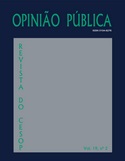Resumo
Por que municípios próximos tendem a ter resultados eleitorais semelhantes? Testam-se aqui três possíveis explicações: as interações sociais entre residentes de municípios próximos; a concentração das campanhas eleitorais em determinadas regiões em detrimento de outras; e as similaridades socioeconômicas observadas entre municípios próximos. Com dados das eleições de 2010 e ferramentas de econometria espacial, a primeira hipótese foi rejeitada; a segunda hipótese foi corroborada preliminarmente; e a terceira hipótese foi corroborada inequivocamente. Os dados mostram ainda que Dilma Rousseff "herdou" a base geográfica de Lula e que essa base é bastante diferente da do PT, que continua sobretudo um partido urbano.
Abstract:
Why do nearby towns tend to have similar electoral results? We test here three possible explanations: social interactions between inhabitants of nearby towns; the concentration of campaign strategies in some areas to the detriment of other areas; and the socioeconomic similarities of nearby towns. Using data from the 2010 elections and spatial econometrics, we rejected the first hypothesis; we found some preliminary support for the second hypothesis; and we found unequivocal support for the third hypothesis. The data also show that Dilma Rousseff “inherited” Lula’s electoral basis of support and that this is quite different from that of the PT, which remains an urban-based party.
Keywords: electoral geography; spatial econometrics; Workers’ Party
Referências
ANSELIN, L. Spatial econometrics. In: MILLS, T. & PATTERSON, K. (Eds.). Palgrave Handbook of Econometrics. Basingstoke: Palgrave Macmillan, vol.1, p. 901-941, 2006.
ANSELIN, L.; & FLORAX, R. Introduction. In: ANSELIN, L. & FLORAX, R. (Eds.). New directions in spatial econometrics. Berlin: Springer, p. 3-18, 1995.
ARRAIZ, I.; DRUKKER, D.; KELEJIAN, H. & PRUCHA, I. “A spatial Cliff-Ord-type model with heteroskedastic innovations: small and large sample results.” Journal of Regional Science, vol. 50, n° 2, p. 592–614, 2010.
CARRARO, A.; ARAÚJO JUNIOR, A.; DAMÉ, O.; MONASTERIO, L. & SHIKIDA, C. ‘É a economia companheiro!’: uma análise empírica da reeleição de Lula com dados municipais [Online]. IBMEC-MG, 2007. Disponível em: <http://ceaee.ibmecmg.br/wp/wp41.pdf>. Acesso em: 23 mar. 2012.
CHO, W. & GIMPEL, J. “Rough terrain: spatial variation in campaign contributing and volunteerism.” American Journal of Political Science, vol. 54, n° 1, p. 74-89, 2007.
FOTHERINGHAM, A.; BRUDSON, C. & CHARLTON, M. Geographically weighted regression: the analysis of spatially varying relationships. Chichester: Jon Wiley & Sons, 2002.
HUCKFELDT, R. & SPRAGUE, J. “Discussant effects on vote choice: intimacy, structure, and interdependence.” Journal of Politics, vol. 53, n° 1, p. 122-158, 1991.
HUNTER, W. & POWER, T. “Rewarding Lula: executive power, social policy, and the Brazilian elections of 2006.” Latin American Politics & Society, vol. 49, n° 1, p. 1-30, 2008.
KELEJIAN, H. & PRUCHA, I. “Specification and estimation of spatial autoregressive models with autoregressive and heteroskedastic disturbances.” Journal of Econometrics, vol. 157, p. 53-67, 2010.
LEE, L. “Asymptotic distributions of quasi-maximum likelihood estimators for spatial autoregressive models.” Econometrica, vol. 72, n° 6, p. 1899-1925, 2004.
NICOLAU, J. & PEIXOTO, V. Uma disputa em três tempos: uma análise das bases municipais das eleições presidenciais de 2006, [Online]. ANPOCS, 2007. Disponível em: <http://jaironicolau.iesp.uerj.br/artigos/NICOLAU%20&%20PEIXOTO%20ANPOCS2007%20ST%2024%20PARTIDOS% 20E%20SISTEMAS%20PARTIDA%C2%A6%C3%BCRIOS.pdf>. Acesso em: 23 mar. 2012.
NICKERSON, D. “Is voting contagious? Evidence from two field experiments.” American Political Science Review, vol. 102, n° 1, p. 49-57, 2008.
SOARES, G. & TERRON, S. “Dois Lulas: a geografia eleitoral da reeleição (explorando conceitos, métodos e técnicas de análise geoespacial)”. Opinião Pública, vol. 14, n° 2, p. 269-301, 2008.
STRØM, K. Minority government and majority rule. Cambridge: Cambridge University Press, 1990.
TERRON, S. & SOARES, G. “As bases eleitorais de Lula e do PT: do distanciamento ao divórcio.” Opinião Pública, vol. 16, n° 2, p. 310-337, 2010.
TINBERGEN, J. An analysis of world trade flows, the Linder hypothesis and exchange risk. In: TINBERGEN, J. (Ed.). Shaping the world economy. New York: The Twentieth Century Fund, 1962.
WARD, M. & GLEDITSCH, K. Spatial regression models. Los Angeles: Sage, 2008.
ZUCCO, C. “The president’s ‘new’ constituency: Lula and the pragmatic vote in Brazil’s 2006 presidential elections”. Journal of Latin American Studies, vol. 40, n° 1, p. 29-49, 2008.
A Opinião Pública utiliza a licença do Creative Commons (CC), preservando assim, a integridade dos artigos em ambiente de acesso aberto.

